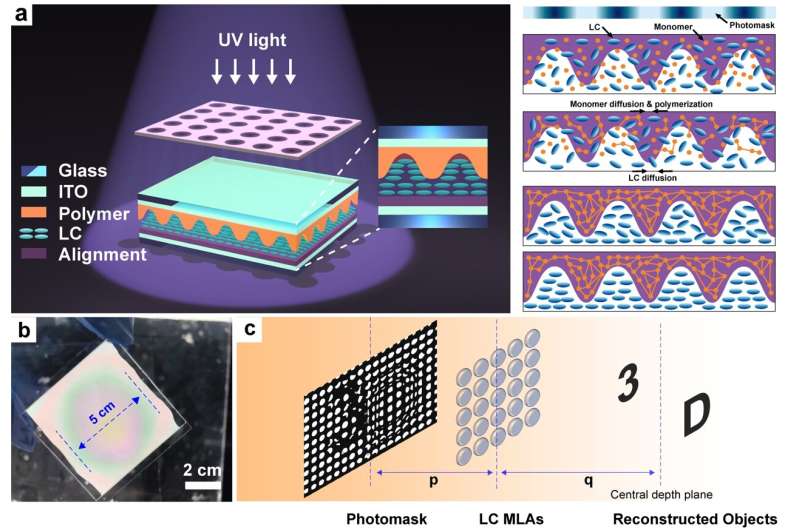This article has been reviewed according to Science X's editorial process and policies. Editors have highlighted the following attributes while ensuring the content's credibility:
fact-checked
trusted source
proofread
Scientists demonstrate electrically tunable microlens array using simple PSCOF approach

Microlens arrays are one of the key elements that are promising in autostereoscopic display, optical communication, wavefront sensing, integral imaging, etc. For example, microlens arrays are the critical components in integral imaging, which are used to collect and display images. In most cases, the image depth in integral imaging is limited due to the fixed focal length of the used microlens arrays.
Liquid crystal (LC) with electrically, optically, or acoustically tunable refraction has been exploited extensively for tunable microlens arrays. Thanks to the tunability of the microlens arrays, the image depth can be explored. However, the design and preparation of the liquid crystal microlens arrays (LC-MLAs) usually involve multiple fabrication processes, increasing fabrication complexity and cost.
In a new paper published in Light: Advanced Manufacturing, a team of scientists, led by Professor Yan Jun Liu from the Department of Electrical and Electronic Engineering, Southern University of Science and Technology, Shenzhen, China cooperates with Professor Yan-Qing Lu from the College of Engineering and Applied Sciences, Nanjing University, Nanjing, China, and co-workers have proposed a simple method to prepare large-area LC-MLAs with only a single-step exposure.
The LC-MLAs are formed via photopolymerization-induced phase separation (PIPS) inside a polymer/LC composite, which yields adjacent layers of LC and polymer known as phase-separated composite films (PSCOFs). The morphology of the composite film can be controlled by a grayscale photomask.
The LC-MLAs demonstrate a high focusing and imaging quality with polarization-dependent, electrically tunable focusing properties. Without applied voltage, the microlens has a natural focal length of 8 mm as a result of its inherent gradient index profile. As the applied voltage exceeds a threshold, the LC reorientation occurs and the focal length of the microlens gradually increases. The researchers demonstrate the realization of image acquisition and electrically tunable central depth plane in 3D displays with the prepared microlens array.
Such a fabricating technology is fundamentally different from the reported ones, such as inkjet printing, compression molding, thermal reflow of photoresist, and three-dimensional printing, which features a facile, single-step, low-cost, and high-throughput production.
In addition, with a purposely designed photomask, the technique can be used as a general platform to fabricate liquid crystal micro-optical devices with other functions, such as liquid crystal lenticular microlens arrays, liquid crystal blazed gratings, etc.
More information: Wenfeng Cai et al, Optically anisotropic, electrically tunable microlens arrays formed via single-step photopolymerization-induced phase separation in polymer/liquid-crystal composite materials, Light: Advanced Manufacturing (2023). DOI: 10.37188/lam.2023.028
Provided by Chinese Academy of Sciences





















